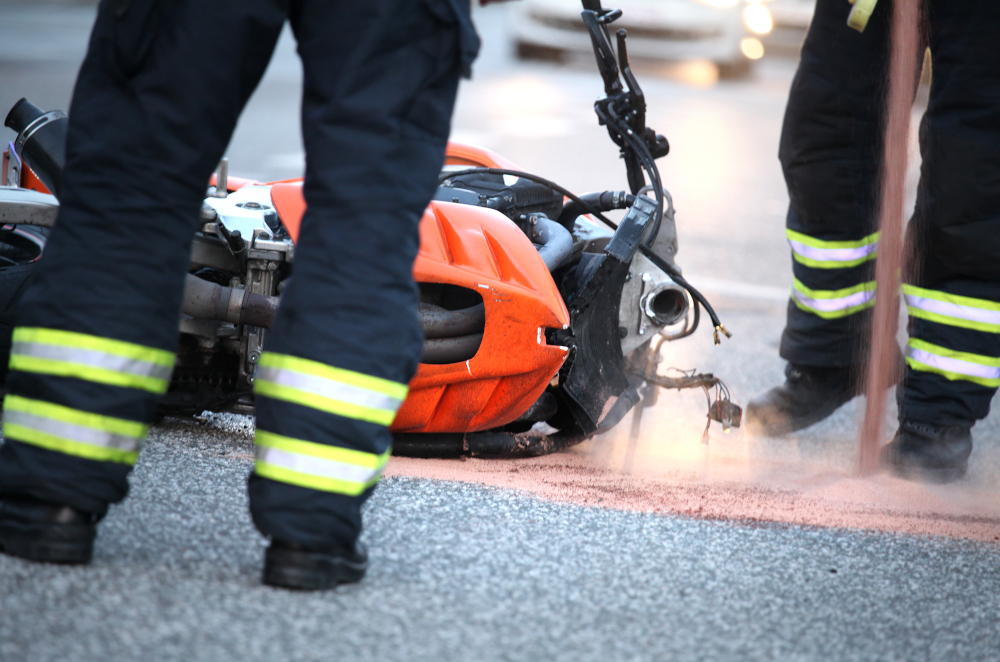Common road hazards to avoid on a motorcycle
Avoid accidents caused by hazards on the road.

The roads are not always friendly to motorcyclists. One ride out is enough to showcase the number of potential hazards which motorcyclists will have to deal with, from nasty potholes to construction materials and all other kinds of hazards that will be a cause for concern. Road hazards can be very scary for motorcyclists and can cause many riders to panic for fear of an accident. Every problem has a solution, and knowing how to avoid mishaps from road hazards can be learned. Here are some of the more common hazards you will encounter on the road, and what you can do to avoid them.
Dirt and Mud

Because many roads in the Philippines pass through areas that are not heavily urbanized, finding a patch of dirt or mud along your path may not be too far-fetched of a situation. When you ride over dirt and mud, the largest effect on your ride will be a loss of traction. Under unfavorable circumstances, this can cause your tire to slip progressively and can lead to an accident. If you have to run over a patch of dirt or mud along the road, your goal as a rider is to make sure that you do not create too much load on the tire.
If the road is a straight line, you shouldn’t have any big issues. Slow down very slightly to a comfortable speed and maintain it. You shouldn’t break or accelerate since this will create a load on the tires. Maintain your speed and keep loose on the bars, and you should be good. If you’re running over a patch of dirt or mud on a corner, you must follow the same protocols, except this time, you should try to stand your bike up as much as possible, and your body should also lean slightly away from the corner. This should reduce a significant amount of load on your tire.
Oil Spills

If you’re out on your bike during a very dry day, and you spot a heavy stain on the road that looks to be wet, you might just be headed towards an oil spill. During rainy days, on the other hand, oil spills will appear as a rainbow color on the road. Oil spills are very tricky situations to handle. The effects of oil on the motorcycle are very similar to the effect of dirt and mud: a loss of traction which can make your tire slide around. However, oil is a lot more slippery than dirt or mud, and keeping traction over oil will be much more tricky when compared to dirt or mud.
When on a straight line, follow the same protocol as with dirt and mud. Stay loose on the bars, and keep a steady speed. On a corner, however, the story changes a little bit. If there is space to avoid running over the spill, this should be your best option. However, if you cannot avoid the spill altogether, the best way to avoid an accident is to try to straighten your line as much as possible. Take the corner a bit wide, and before the spill, head towards the center of the lane and keep a straight line towards the exit. After you’ve gone over the oil, be sure to stay cautious and ride conservatively – there might still be a bit of leftover oil on your tire. After a few hundred meters of riding, you should be good to continue on with your desired pace.
Manhole Covers and Steel Plates

The last kind of obstacles that will directly affect tire traction are manhole covers and steel plates on the road. Again, the effect on the tire and your motorcycle will be similar to oil spills and dirt or mud, and so your goal as a rider will be similar as well: reduce the amount of load your tires will receive. Many riders tend to avoid these obstacles completely, but in many cases, riders become hazards themselves when panic braking or swerving spontaneously. As a rider, you don’t need to do this. In fact, manhole covers and steel plates are the safest obstacles to ride over in this list.
When going over these kinds of obstacles, following the same protocol as with dirt and mud will be enough. Simply remain loose on the bars, keep your lower body planted, and keep steady on your throttle. When cornering, the protocols are still quite similar. If the weather is dry, lean out of the corner and stand the bike up. Take the obstacle at a slightly slower and consistent speed. When it’s raining, however, it would be best to take this obstacle like an oil spill: avoid if the situation permits and straighten out your line. Regardless of your decision and your situation, always remember that the last thing you want to be as a rider is to be a hazard to other motorists on the road.
Potholes

Considered to be the enemy of many riders, and an alarming cause for accidents to others, potholes are one of the most common obstacles a rider will face on local roads. Potholes come in many shapes and sizes. The more common potholes you will find are the smaller cracks and holes on the road which are typically shallow at just 1-2 inches in depth. If you’re headed for a small pothole, there shouldn’t be any cause for concern. Stay loose on the handlebars and use your legs to keep your lower body planted on the motorcycle. The goal is to guide your motorcycle over it.
However, if you’re headed towards a very large pothole, spanning over 6 inches in diameter and a few inches deep, steering clear would be the best solution in order to avoid damage to your motorcycle. The goal here would be to avoid the obstacle as much as possible without disrupting the flow of traffic. You can easily become a hazard if you disrupt the flow of traffic. If you can ride around the obstacle, this would be your best option. However if circumstances do not allow you to ride around it, the next best solution would be to reduce speed slowly and take on the pothole slowly. Try to find the shallowest spot on the pothole, and ride over it at around 10-20 kph. If you make sure that you do not become the hazard yourself, and are able to take on the pothole at a reasonable speed, you should be okay.
Road Debris

Road debris is another kind of hazard which all motorcyclists will one day have to deal with. It may be an empty plastic bag, a cardboard box, a stray shoe, or something else entirely. When faced with the obstacle of road debris, the single thing you need to know is whether or not the item is a solid and bulky object. For debris that is not bulky, like plastic bags or small tree branches, nearly all kinds of motorcycles are built to take them head-on. Simply keep loose on the bars, ride over this type of hazard, and keep a straight line. Your motorcycle is built to handle this. However, for bulkier objects like cardboard boxes with items inside or a large rock on the road, avoidance will be your best option. Slowly squeeze on the brakes and change your line to avoid the object so that you don’t disrupt the flow of traffic and be a hazard yourself.
Related Articles
-
5 things to remember when shopping for new motorcycle tires / Featured Article
Here are 5 things to consider when time comes for you to replace the tires on your motorcycle.
-
Can't ride your motorcycle because it's raining? Do these 4 things instead / Featured Article
Here’s a quick listicle of activities you can do if you can’t ride your motorcycle because of bad weather.
-
Which motorcycle jacket should you buy for your riding style? / Featured Article
There are a multitude of options when it comes to riding jackets. Let’s take a closer look at some of the most popular types.
-
Top 5 greatest motorcycle tech advancements of the modern era / Featured Article
Here are what we consider as the top 5 greatest motorcycle innovations of the past decade or so.
-
5 tips to keep thieves away from your motorcycle / Featured Article
Here are 5 things to consider when it comes to keeping your motorcycle safe and secure from prying eyes.
Latest Features
-
Last-minute Christmas gift ideas for your rider friends and family / Featured Article
Struggling to think of gift ideas for your motorcyclist friends and family? Read on to get some inspiration this gift-giving season.
-
Ride a naked sportbike? Get these 5 upgrades first / Featured Article
Here’s a quick list of 5 upgrades to your naked sportbike to enhance your riding experience.
-
Motorcycle 101: The inner workings of a slipper clutch / Featured Article
Slipper clutches are awesome as they make for more forgiving downshifts and a lighter clutch lever. Let’s take a closer look at them and see how they work.








